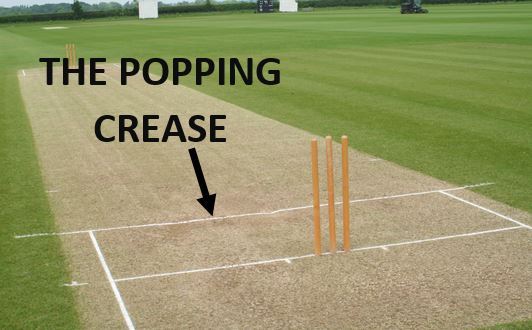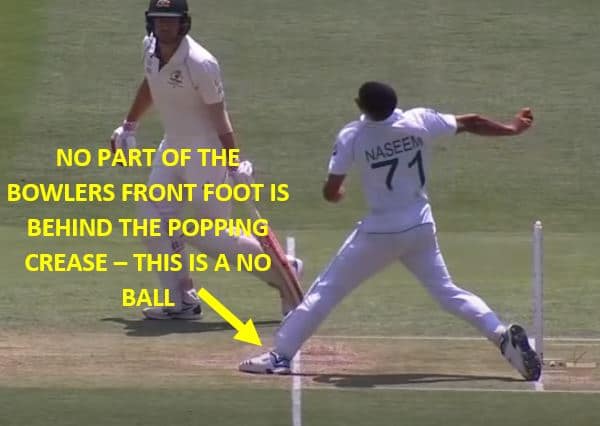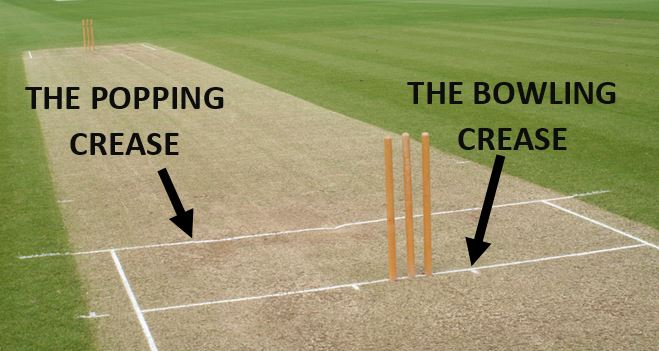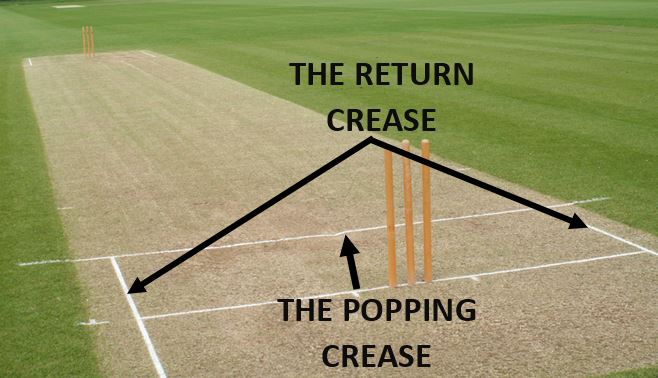A cricket field is a large playing surface, and as a result there are many areas of the field that have different names! One of the main sections of the field is the actual cricket pitch – a 22-metre long rectangular area where all of the batting and bowling during cricket matches takes place. The cricket pitch is also divided into many smaller sections, one of which is the popping crease!
The popping crease is a very important part of cricket. All of the batsmen, bowlers, fielders and officials involved with the sport should know exactly what role it plays and how it impacts the game. So, if you’ve been wondering what the popping crease is and what the rules surrounding it are, you’re in the right place!
So, what is the popping crease?
The popping crease is a line that runs horizontally across a cricket pitch, 4 feet in front of the stumps. Bowlers must get part of their front foot behind this line when bowling or else a no ball will be called. Batsmen must keep a part of their body/bat grounded behind this line, or they may be run out or stumped.

The photo above shows exactly where the popping crease is located on a cricket pitch, as well as what it looks like. As you can see in the photo, the popping crease is usually marked on the pitch with a bright white whitewash or paint. The marking shouldn’t really be more than 1 inch in thickness.
What Impact Does The Popping Crease Have On The Game?
As I mentioned above, batsmen and bowlers will have to be aware of the popping crease for different reasons. Allow me to explain why below…
Batsmen
When the ball is in play, a batsman must ensure that they have part of their body (or their bat, which is considered to be an extension of their body) grounded behind the popping crease line. If they step out from behind the line, for example when advancing down the wicket to a spin bowler or attempting a quick run, they are at risk of being stumped or run out.
Stumpings can only be carried out by the wicket keeper and will usually happen when a spin bowler is bowling. If the batsman skips down the pitch or lunges forward and allows their back foot to leave the crease, then the wicket keeper can catch the ball and whip off the bails. If the batsman doesn’t get part of their body (or bat) back over the popping crease line by the time the keeper whips off the bails, they’ll be out stumped.

Run outs are slightly different to stumpings in the fact that they can be carried out by any fielder – not just the wicket keeper! Additionally, run outs allow the fielders to throw the ball at the stumps as well as hitting the stumps with the ball in their hands. To give you an example of how run outs occur, imagine Joe Root is batting against Jasprit Bumrah and he hits the ball towards the cover fielder before setting off for a quick single. The cover fielder moves in quickly, picks up the ball and throws it towards the stumps. Root is now sprinting towards the non-striker’s end, and he knows that he needs to get his bat or another part of his body grounded past the line of the popping crease before the ball strikes the stumps. If he fails, and the ball strikes the stumps and knocks off the bails, he will be given out run out. You see batsmen get run out regularly in the game of cricket – so this is one to watch out for!
Bowlers
As bowlers go through their bowling action, their front foot is the last thing that makes contact with the ground before they release the ball. For right arm bowlers the front foot is most often the left foot, and for left arm bowlers the front foot is most often the right foot. Most bowlers will aim for their front foot to land on or around the popping crease, but some bowlers get this wrong and end up going too far over the line!
If the bowler does not get part of their front foot behind the line of the popping crease, then the umpire will declare that delivery to be a no ball. In matches where video technology is not available, this often requires the umpire to watch where the bowler’s foot is landing before they release the ball. However, some matches that have DRS review systems in place now leave the calling of front foot no balls to the TV umpires.
So, to summarise, even if a bowler gets a tiny fraction of their front foot behind the line of the popping crease, this will be deemed a legal delivery. Funnily enough, the foot doesn’t even need to be grounded behind the line! If the bowler has their heel in the air, but it is over the line of the popping crease, this would still be declared a legal delivery.

Why Is It Called The ‘Popping’ Crease?
The origin of the ‘popping crease’ name goes all the way back to the earliest days of cricket, when it was a very different game to the one we see lighting up our TV screens today! In the early days of the sport, a batsman could only complete a run by inserting his bat into a hole that had been cut into the ground at the other end of the pitch. These holes in the ground were known as ‘popping holes’. If the fielding side managed to get the ball into the popping hole before the batsman inserted his bat, then this would be a run out.
Over time, the rules and set up of the game changed somewhat, and popping holes were removed. Instead, it was decided that the batsman would have to place their bat over a line in order to signal a completed run. This line became known as the ‘popping crease’ due to the holes it had replaced!
What’s The Difference Between The Popping Crease & The Bowling Crease?
Many newcomers to the game of cricket often wonder if the popping crease and the bowling crease are the same thing – but the answer to this is no!
The popping crease and the bowling crease are separate parts of the pitch. The popping crease as we’ve discussed is a horizontal line that is 4 feet (1.2 metres) in front of each set of stumps. The bowling crease is also a horizontal line but it is further back, on the same line as the stumps. The stumps are inserted into the ground in the centre of the bowling crease! You can see the relationship between the popping crease and the bowling crease in the diagram below.

What’s The Difference Between The Popping Crease & The Return Crease?
By this point you may be wondering how many creases there are in the game of cricket – and to be honest if you are wondering that then I don’t blame you! Don’t worry though, the return crease is the last one we’re going to cover in this post!
So where is the return crease and what is its relationship with the popping crease? The return crease is a vertical line that runs perpendicular to the popping crease, and there are two of them at each end of the cricket pitch. It helps to signify the width of the pitch, as well as helping the umpire decide if the bowler has bowled a return crease no ball or not!
If you don’t know what a return crease no ball is, then allow me to explain. If any part of a bowler’s back foot crosses the line of the return crease when they’re in their delivery stride, the umpire will call a no ball. This will occur most often when the bowler is bowling from wide on the crease!
The diagram below should explain what the return crease is and how it relates to the popping crease.

What Is The Length Of The Popping Crease?
The popping crease runs horizontally across the entire length of the cricket pitch. A cricket pitch is approximately 10 feet (3.05 metres) wide, so this means that the popping crease is also 10 feet in length.
